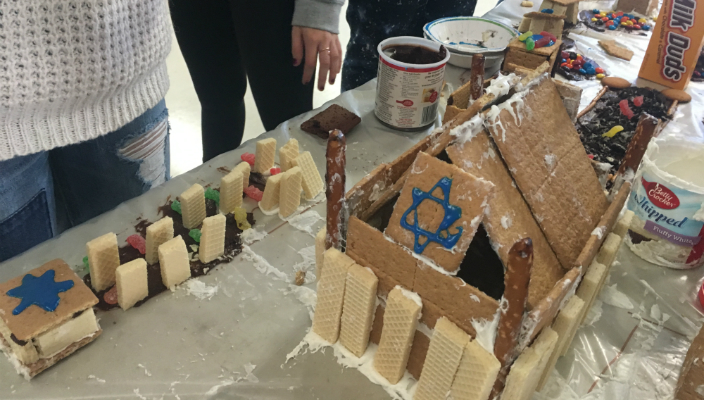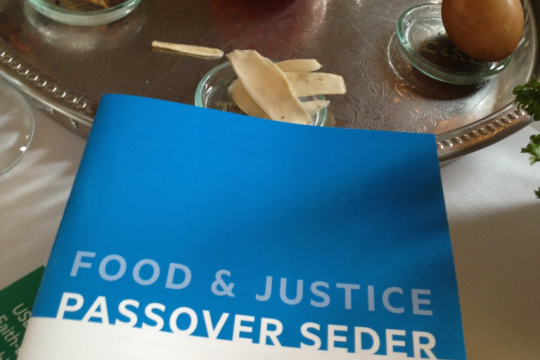
When teens at a regional NFTY event ask when you are going to repeat the program they just attended, you must be doing something right. Coming out of the program, it was clear that they were happy – happy because they were fully engaged, had fun, and because along the way, they learned something about themselves, their peers, their identity and their heritage.
It all started when my friend, Rachel Alemany, a fellow youth group advisor and educator, had an idea that Jewish teens should have a winter experience that was akin to building gingerbread houses. We decided to take it a step further, by adding educational elements that were Jewish and experiential, so I went to my resource library for inspiration. With picture books and archival photographs in hand, the “Edible Shtetl” program was born. Many years later, the program is now more formally known as "Shtetl: Jewish Community Life Before the Holocaust." Our NFTY teens still affectionately call it by its original name.
The Edible Shtetl program is about how the Jewish people lived in Eastern Europe before the Holocaust. Participants read picture books in small groups and report back to the whole group on the plot, illustrations and message of the story. In analyzing picture books, students learn about the narratives and folktales of Jewish villages, develop an eye for the aesthetics of small town living, and reflect on shared community values. They then review archival photographs, make a list of what parts of a town they will need to build, map out their shtetl for table-top construction and build with lots of candy, cookies and chocolate icing. The icing represents the ubiquitous mud found everywhere in the shtetl and is an alternative to the white gingerbread house icing that proved unsuccessful as glue in early attempts. In its later iterations, participants have sometimes requested specific types of candy to realize their artistic vision.
Often, we begin the program introductions by asking participants if they know where their family comes from. It's possible that the group self-selects, but a surprising number have roots in Eastern Europe. Sometimes we ask if they know any Yiddish words or phrases. Community building by sharing family history and culture instead of contemporaneous teenage experience is an alternative, unexpected way to build both Jewish identity and community at a NFTY event.
One of the best things about "Edible Shtetl" is how accessible the program materials are. The subject of Holocaust study can be daunting. Picture books and candy offer a safe, accessible and familiar way to approach this difficult chapter of history. Everyone associates positively with a picture book story and accompanying illustrations and, of course, teens love candy.
The program appeals to all types of learners. There is room for verbal, visual and tactile contributions. The friendly nature of the building process allows everyone to access their creativity, whether it's in a small group or on an individual basis. There is no wrong way to enact this. The project is scaffolded for all ages and abilities. Participants often gravitate to building a particular structure or part of the shtetl and take great pride in their construction. That's usually particularly true of whoever takes responsibility for building the shtetl's synagogue, but no less validating for those who build roads, bridges, homes, shops or the central marketplace. If you feel fudge icing is too messy (or tempting) and graham crackers are too crumbly, you're welcome to try the project with found objects (such as cereal boxes, papers, buttons, beads or things you find in nature).
Lastly, "Edible Shtetl" can be appreciated by those who did not attend the program.
Whether in formal presentation, friendly sharing, or ongoing display, the learning that takes place in "Edible Shtetl" becomes part of a community legacy. It finds its way back to the synagogue and accompanies participants home to their families. We've heard stories about how the experience opened conversation between generations.
When Rachel and I invented "Edible Shtetl," we didn't know we were teaching a program about the Holocaust. Now, we never tire of teaching it or talking about it with students or other educators who have witnessed its rewards. It has deepened in meaning for us over the years. This year, Rachel and I felt especially proud to receive the 2018 Korzenik Holocaust Educator Award from the Maurice Greenberg Center for Jewish Studies at the University of Hartford. As we said in our award application, "We can honor the victims of the Holocaust not only by remembering and cataloguing their deaths but by learning about and paying tribute to how they lived. Elie Wiesel wrote, 'Just as memory preserves the past, so does it insure our future, and our dedication is to both.' Bringing the shtetl to life for a new generation serves that calling."
Jeanette Brod Lazer is the director of lifelong learning at Temple Sholom in New Milford, CT.
Have something to say about this post? Join the conversation in The Tent, the social network for congregational leaders of the Reform Movement. You can also tweet us or tell us how you feel on Facebook.
Related Posts

Passover 2024: The Three Central Messages of Pesach

Modern-Day Plagues of Injustice and Inequality
